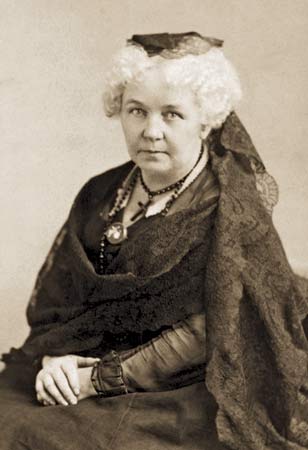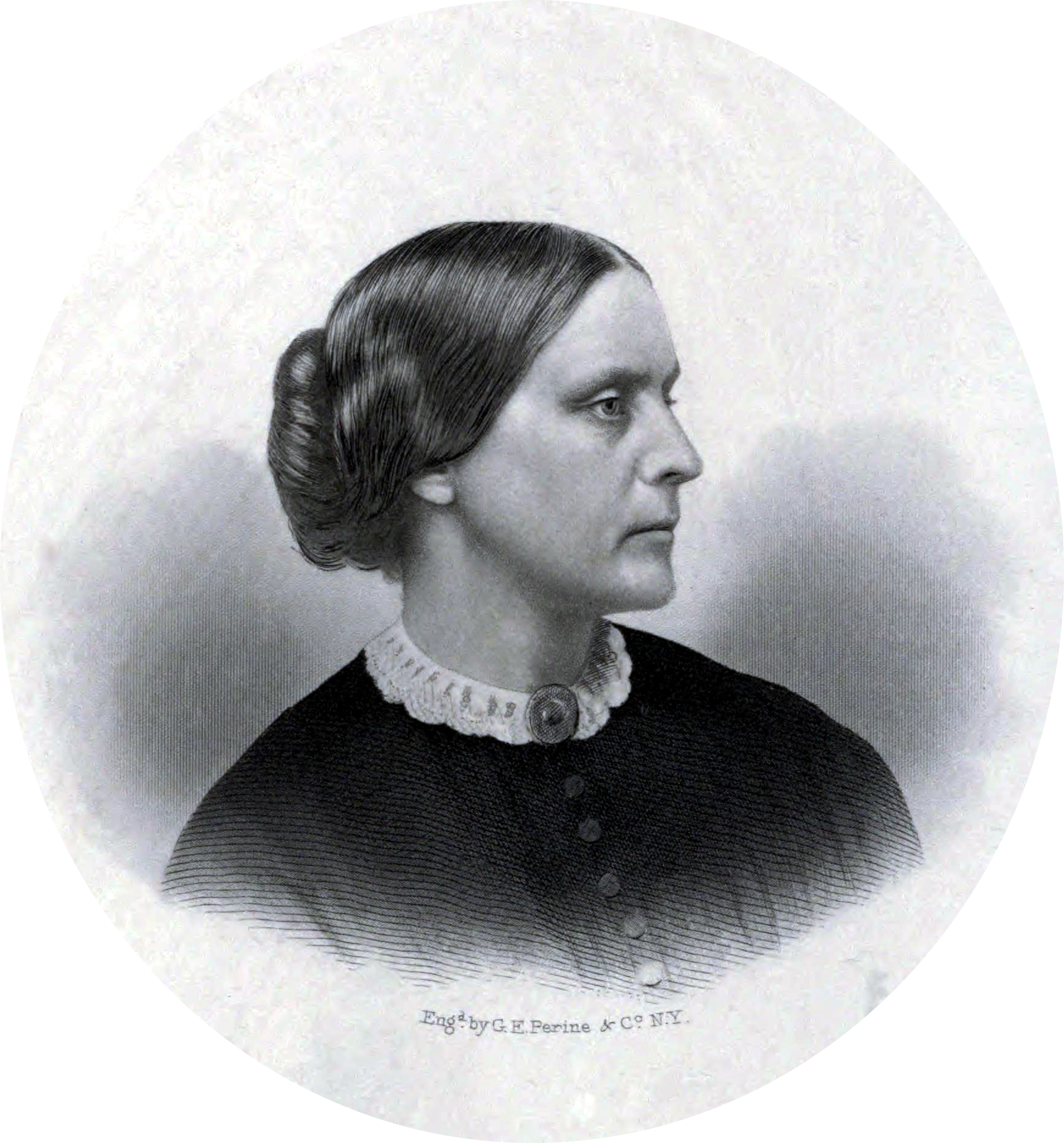Susan Brownell Anthony was an American social reformer and feminist who played a pivotal role in the women's suffrage movement. Born into a Quaker family committed to social equality, she collected anti-slavery petitions at the age of 17. In 1856, she became the New York state agent for the American Anti-Slavery Society.
Abolitionist
After they moved to Rochester in 1845, members of the Anthony family were active in the anti-slavery movement. Anti-slavery Quakers met at their farm almost every Sunday, where they were sometimes joined by Frederick Douglass and William Lloyd Garrison. Anthony's brothers Daniel and Merritt were anti-slavery activists in Kansas.
In 1856 Anthony became an agent for the American Anti-Slavery Society, arranging meetings, making speeches, putting up posters, and distributing leaflets. She encountered hostile mobs, armed threats, and things thrown at her. She was hung in effigy, and in Syracuse her image was dragged through the streets.
In 1863 Anthony and Stanton organized a Women's National Loyal League to support and petition for the Thirteenth Amendment outlawing slavery. They went on to campaign for full citizenship for women and people of any race, including the right to vote, in the Fourteenth and Fifteenth Amendments. They were bitterly disappointed and disillusioned when women were excluded. Anthony continued to campaign for equal rights for all American citizens, including people who had been enslaved, in her newspaper The Revolution, which she began publishing in Rochester in 1868. Anthony attacked lynchings and racial prejudice in the Rochester newspapers in the 1890s.
Educational Reformer
In 1846, at age 26, Susan B. Anthony took the position of head of the girls' department at Canajoharie Academy, her first paid position. She taught there for two years, earning $110 a year.
In 1853 at the state teachers' convention Anthony called for women to be admitted to the professions and for better pay for women teachers. She also asked for women to have a voice at the convention and to assume committee positions.
In 1859 Anthony spoke before the state teachers' convention at Troy, N.Y. and at the Massachusetts teachers' convention, arguing for coeducation (boys and girls together) and claiming there were no differences between the minds of men and women.
Anthony called for equal educational opportunities for all regardless of race, and for all schools, colleges, and universities to open their doors to women and people who had been enslaved. She also campaigned for the right of children of people who had been enslaved to be able to attend public schools.
In the 1890s Anthony served on the board of trustees of Rochester's State Industrial School, campaigning for coeducation and equal treatment and opportunity for boys and girls.
In the 1890s Anthony raised $50,000 in pledges to ensure the admittance of women to the University of Rochester. In a last-minute effort to meet the deadline she put up the cash value of her life insurance policy. The University was forced to make good its promise and women were admitted for the first time in 1900.
Labor Activist
Susan B. Anthony's paper The Revolution, first published in 1868, advocated an eight-hour work day and equal pay for equal work. It promoted a policy of purchasing American-made goods and encouraging immigration to rebuild the South and settle the entire country. Publishing The Revolution in New York brought her in contact with women in the printing trades.
In 1868 Anthony encouraged working women from the printing and sewing trades in New York, who were excluded from men's trade unions, to form Workingwomen's Associations. As a delegate to the National Labor Congress in 1868 Anthony persuaded the committee on female labor to call for votes for women and equal pay for equal work, although the men at the conference deleted the reference to the vote.
In 1870 Anthony formed and was elected president of the Workingwomen's Central Association. The Association drew up reports on working conditions and provided educational opportunities for working women. Anthony encouraged a cooperative workshop founded by the Sewing Machine Operators Union and boosted the newly-formed women typesetters' union in The Revolution. Anthony tried to establish trade schools for women printers. When printers in New York went on strike, she urged employers to hire women instead, believing this would show that they could do the job as well as men, and therefore prove that they deserved equal pay. At the 1869 National Labor Union Congress, the men's Typographical Union accused her of strike- breaking and running a non-union shop at The Revolution, and called her an enemy of labor.
In the 1890s, while president of the National American Woman Suffrage Association, Anthony emphasized the importance of gaining the support of organized labor. She encouraged Florence Kelley and Jane Addams in their work in Chicago, and Gail Laughlin in her goal to seek protection for working women through trade unions.
Temperance Worker
Susan B. Anthony was brought up a Quaker. Her family believed drinking liquor was sinful. While Anthony was working as head of the girls' department of Canajoharie Academy she joined the Daughters of Temperance, a group of women who drew attention to the effects of drunkenness on families and campaigned for stronger liquor laws. She made her first public speech in 1848 at a Daughters of Temperance supper.
When Anthony returned to Rochester in 1849 she was elected president of the Rochester branch of the Daughters of Temperance and raised money for the cause. In 1853 Anthony was refused the right to speak at the state convention of the Sons of Temperance in Albany. She left the meeting and called her own. In 1853 Anthony and Elizabeth Cady Stanton founded the Women's State Temperance Society with the goal of petitioning the State legislature to pass a law limiting the sale of liquor. The State Legislature rejected the petition because most of the 28,000 signatures were from women and children. Anthony decided that women needed the vote so that politicians would listen to them. She and Stanton were criticized for talking too much about women's rights and resigned from the Women's State Temperance Society.
In the 1860s Anthony and Stanton drew attention to the case of Abby McFarland whose drunken and abusive husband, Daniel, shot and killed the man she had divorced him to marry. They protested when Daniel was acquitted of murder on a plea of temporary insanity and given custody of their son.
In the 1870s Anthony supported the Rochester women organizers of the Women's Christian Temperance Union, although she told them that women would need to get the vote to reach their goal. She refused to support Prohibition because she believed it detracted attention from the cause of woman suffrage.
Suffragist
Susan B. Anthony was convinced by her work for temperance that women needed the vote if they were to influence public affairs. She was introduced by Amelia Bloomer to Elizabeth Cady Stanton, one of the leaders of the women's rights movement, in 1851, and attended her first women's rights convention in Syracuse in 1852.
Anthony and Stanton believed the Republicans would reward women for their work in building support for the Thirteenth Amendment by giving them the vote. They were bitterly disappointed when this did not happen.
In 1866 Anthony and Stanton founded the American Equal Rights Association and in 1868 they started publishing the newspaper The Revolution in Rochester, with the masthead "Men their rights, and nothing more; women, their rights, and nothing less," and the aim of establishing "justice for all."
In 1869 the suffrage movement split, with Anthony and Stanton's National Association continuing to campaign for a constitutional amendment, and the American Woman Suffrage Association adopting a strategy of getting the vote for women on a state-by-state basis. Wyoming became the first territory to give women the vote in 1869.
In the 1870s Anthony campaigned vigorously for women's suffrage on speaking tours in the West. Anthony, three of her sisters, and other women were arrested in Rochester in 1872 for voting. Anthony refused to pay her streetcar fare to the police station because she was "traveling under protest at the government's expense." She was arraigned with other women and the election inspectors who had allowed her to vote in Rochester Common Council chambers. She refused to pay bail and applied for habeas corpus, but her lawyer paid the bail, keeping the case from the Supreme Court. She was indicted in Albany, and the Rochester District Attorney asked for a change of venue because a jury might be prejudiced in her favor. At her trial in Canandaigua in 1873, the judge instructed the jury to find her guilty without discussion. (The jury didn't get to discuss the verdict!) He fined her $100 and made her pay courtroom fees, but did not imprison her when she refused to pay, therefore denying her the chance to appeal.
In 1877, she gathered petitions from 26 states with 10,000 signatures, but Congress laughed at them. She appeared before every congress from 1869 to 1906 to ask for passage of a suffrage amendment. Between 1881 and 1885 Anthony, Stanton and Matilda Joslin Gage collaborated on and published the History of Woman Suffrage. The last volume, edited by Anthony and Ida Husted Harper, was published in 1902.
In 1887 the two women's suffrage organizations merged as the National American Woman Suffrage Association with Stanton as president and Anthony as vice-president. Anthony became president in 1892 when Stanton retired. Anthony campaigned in the West in the 1890s to make sure that territories where women had the vote were not blocked from admission to the Union. She attended the International Council of Women at the 1893 World's Fair in Chicago.
In 1900, aged 80, Anthony retired as President of NAWSA. In 1904 Anthony presided over the International Council of Women in Berlin and became honorary president of Carrie Chapman Catt's International Woman Suffrage Alliance.
Susan B. Anthony died in 1906 at her home on Madison Street in Rochester. All American adult women finally got the vote with the Nineteenth Amendment, also known as the Susan B. Anthony Amendment, in 1920.
Women's Rights Campaigner
Susan B. Anthony advocated dress reform for women. She cut her hair and wore the bloomer costume for a year before ridicule convinced her that this radical dress detracted from the other causes she supported.
In 1853 Anthony began to campaign for women's property rights in New York state, speaking at meetings, collecting signatures for petitions, and lobbying the state legislature. In 1860, largely as the result of her efforts, the New York State Married Women's Property Bill became law, allowing married women to own property, keep their own wages, and have custody of their children. Anthony and Elizabeth Cady Stanton campaigned for more liberal divorce laws in New York.
In 1869 Anthony persuaded the Workingwomen's Association in New York to investigate the case of Hester Vaughn, a poor working woman accused of murdering her illegitimate child. Vaughn was pardoned, and Anthony used the case to point out the different moral standards expected of men and women and the need for women jurors to ensure a fair trial.
In 1875 she attacked the "social evil" of prostitution in a speech in Chicago, calling for equality in marriage, in the workplace, and at the ballot box to eliminate the need for women to go on the streets.











